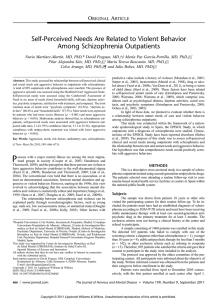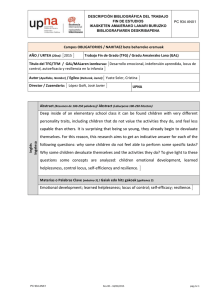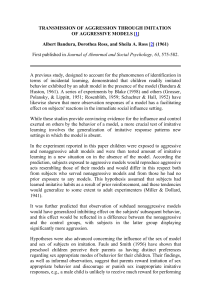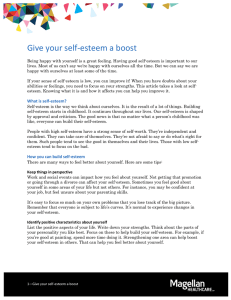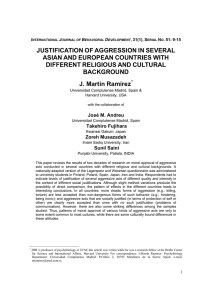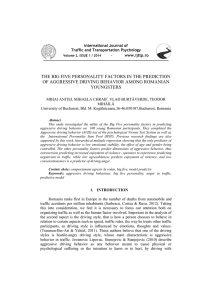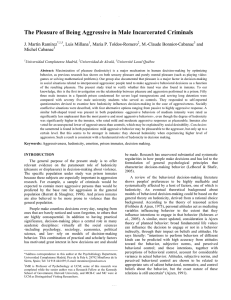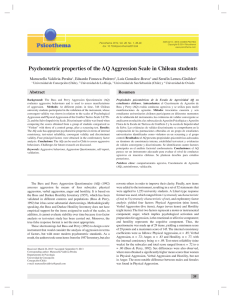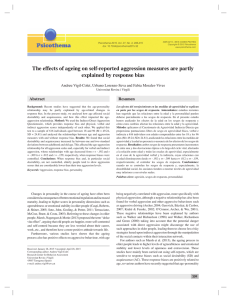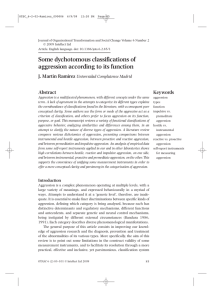aggressive tendencies amo ng undergraduates: the role - e
Anuncio
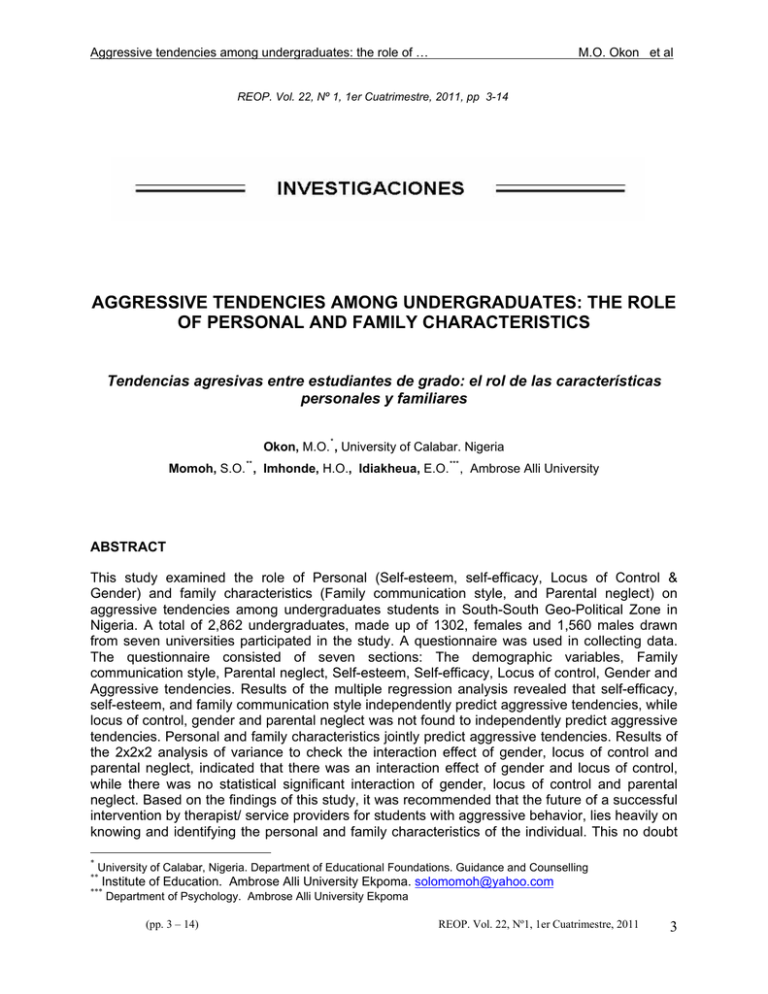
Aggressive tendencies among undergraduates: the role of … M.O. Okon et al REOP. Vol. 22, Nº 1, 1er Cuatrimestre, 2011, pp 3-14 AGGRESSIVE TENDENCIES AMONG UNDERGRADUATES: THE ROLE OF PERSONAL AND FAMILY CHARACTERISTICS Tendencias agresivas entre estudiantes de grado: el rol de las características personales y familiares Okon, M.O. * , University of Calabar. Nigeria Momoh, S.O. ** , Imhonde, H.O., Idiakheua, E.O. *** , Ambrose Alli University ABSTRACT This study examined the role of Personal (Self-esteem, self-efficacy, Locus of Control & Gender) and family characteristics (Family communication style, and Parental neglect) on aggressive tendencies among undergraduates students in South-South Geo-Political Zone in Nigeria. A total of 2,862 undergraduates, made up of 1302, females and 1,560 males drawn from seven universities participated in the study. A questionnaire was used in collecting data. The questionnaire consisted of seven sections: The demographic variables, Family communication style, Parental neglect, Self-esteem, Self-efficacy, Locus of control, Gender and Aggressive tendencies. Results of the multiple regression analysis revealed that self-efficacy, self-esteem, and family communication style independently predict aggressive tendencies, while locus of control, gender and parental neglect was not found to independently predict aggressive tendencies. Personal and family characteristics jointly predict aggressive tendencies. Results of the 2x2x2 analysis of variance to check the interaction effect of gender, locus of control and parental neglect, indicated that there was an interaction effect of gender and locus of control, while there was no statistical significant interaction of gender, locus of control and parental neglect. Based on the findings of this study, it was recommended that the future of a successful intervention by therapist/ service providers for students with aggressive behavior, lies heavily on knowing and identifying the personal and family characteristics of the individual. This no doubt * University of Calabar, Nigeria. Department of Educational Foundations. Guidance and Counselling ** Institute of Education. Ambrose Alli University Ekpoma. [email protected] *** Department of Psychology. Ambrose Alli University Ekpoma (pp. 3 – 14) REOP. Vol. 22, Nº1, 1er Cuatrimestre, 2011 3 Aggressive tendencies among undergraduates: the role of … M.O. Okon et al would help the therapists to talilor specific treatment for specific individuals. Keywords: Aggression, Self-esteem, Self-efficacy, Family-communication-style, Parentalneglect. RESUMEN Este estudio examina el rol que las características personales (auto-estima, auto-eficacia, locus de control y género) y familiares (estilo de comunicación familiar y abandono parental) juegan en las tendencias agresivas de estudiantes de grado en la zona geopolítica Sur-Sur de Nigeria. Un total de 2.862 estudiantes de grado, compuesta por 1.302 mujeres y 1.560 hombres de siete universidades diferentes participaron en el estudio. Para recoger los datos se utilizó un cuestionario compuesto de siete partes: variables demográficas, Estilo de comunicación familiar, abandono parental, auto-estima, auto-eficacia, locus de control, género y tendencias agresivas. Los resultados de los análisis de regresión múltiple revelan que auto-eficacia, autoestima, y estilo de comunicación familiar predicen independientemente tendencias agresivas, mientras que locus de control, género y abandono parental no predicen independientemente tendencias agresivas. La combinación de tendencias personales y familiares predice tendencias agresivas. Los resultados de los análisis de varianza 2x2x2 para analizar la interacción de género, locus de control y abandono parental indican que existe interacción entre género y locus de control, mientras que no existe interacción estadísticamente significativa entre género, locus de control y abandono parental. En base a los hallazgos de este estudio, se sugiere que el futuro de intervenciones de éxito por terapeutas y proveedores de servicios para estudiantes con comportamiento agresivo depende fuertemente de conocer e identificar las características personales y familiares del individuo. Sin duda esto ayudara a los terapeutas a ajustar tratamientos específicos para cada individuo. Palabras clave: Agresión, autoestima, autoeficacia, estilo de comunicación familiar, negligencia parental. Introduction The use of aggression in achieving ones goals has become rampant among university students in Nigeria. This prompted Nwokoroku (2001) to note that the nation’s institutions of higher education have been turned into a battle field by students. She reported that in the campuses students engage in aggressive acts towards one another and even towards lecturers and non-teaching staff. Students have been observed to engage in such acts of aggression as violence, rape, extortion, burglary, killing, maiming and sexual harassment. They are also frequently associated with invectives, vulgarities, obscenities, allures, abduction and kidnapping and insults at one time or another. These acts of aggression are mostly directed towards lecturers, non-teaching staff, management staff and even towards fellow students. Such acts of aggression are said to bring about tension on campuses. Elegbeleye (2006) found that rape incidents are on the increase in the last ten (pp. 3 – 14) REOP. Vol. 22, Nº1, 1er Cuatrimestre, 2011 4 Aggressive tendencies among undergraduates: the role of … M.O. Okon et al years on university campuses across Nigeria. Aggression in schools intrudes not just on the rights of others but impairs the normal functioning of classroom as well as other settings (Haggai, 2003). Aggression is a term used by Psychologist to describe any behavior by an individual against another with the sole aim of inflicting pain (physical and psychological). Gleitman, Fridlund and Reisberg (2004) noted that relational aggression focuses on altering social alliances such as trying to harm another’s friendship. Physical aggression involves physical abuse of another person’s property, while verbal aggression involves insults, invective and so forth. Ellis (2004) categorises aggression into healthy and unhealthy. He described healthy aggression as the aggressiveness that tends to abet the goals of remaining alive; being relatively happy; living successfully in a social group and relating intimately with some selected members of the group. It could also mean decisively, vigorously and persistently going after a goal. On the other hand, he conceptualized unhealthy aggression as the form of aggressiveness which tends to undermine basic human goals. These behaviors are such that are based on what he calls “irrational masturbatory cognitions that block the fulfilling of the laudable values, goals, and aspirations of an individual as well as a group”. These are various ways in which aggression may be categorised. Irrespective of the way aggression may be grouped, it serves as a utilitarian value for the aggressor (Franzoi, 2000). Obviously, though aggressive acts hurt the victim, it creates a variety of results for the aggressor. Hence, Geen (1995) noted that aggression is one means by which some people seek to maintain or restore their self-esteem. Baumeister, Smart and Boden (1996) found that aggression is commonly a result of threat to highly favourable views of self and is most likely to occur when a person’s self-esteem is fragile and unstable. Several reasons have been listed for aggression. For example, physical aggression is used to gain relevance, gain control or dominance over other people, secure material resources, as well as to effect change in social practices that adversely affects one’s everyday life. Aggression may result from the early socialization of children. Families play an important role in the socialization of children. Invariably, parental characteristics and imitation of parents by children influence social development in subtle ways. The role of families in socialization is reflected in the literature of youth at risk (Domadge, 1995). This study demonstrates the importance of family processes and family dynamics in promoting and maintaining aggressive behaviors and attitudes, negative feelings of home, serious conflicts with parents and regular quarrels with parents are some of the home based factors reported to constitute risk for adolescent’s aggressive behavior. Bocco (2002), Nwokoroku (2001), and Farrington (1992), examined the association between aggressive behaviors in adolescent and family variables such as social learnings, parenting style and exposure to violence. Bjorkqvist and Osterman (1992), carried out a structural equation and analysis examining the interaction between parental behavior, emotional relationship with parents and children’ aggressiveness. The findings revealed that a child’s emotional relationship with the parent was the strongest single predictor of children’s aggressiveness. The emotional climate of the family is determined to a large extent by what happens in the family, for example how (pp. 3 – 14) REOP. Vol. 22, Nº1, 1er Cuatrimestre, 2011 5 Aggressive tendencies among undergraduates: the role of … M.O. Okon et al family members feel about one another and the way they communicate such feelings affect the emotional climate of the home. In the same vein Imhonde, Aluede and Oboite (2009) found that children who witnessed domestic violence scored high on the aggression scale than those who do not. Neglect of children by their parents is another key factor in family relationship. Parents owe it as a duty to their children to provide them with their developmental needs both physically and psychologically. Failure to do these amounts to neglect and abuse. Saner and Ellickson (1996) found that low parental support and affection predicted persistent hitting and predatory violence in the subjects. The relationship between low parental support and violence was however noted to be stronger in females than males. Research also found that parental victimization of children was significantly associated with their perpetration of violence against their parents and friends. Further analysis using a stepwise multiple regression showed that 39 percent of the variance in the subject’s perpetration of violence against parents was accounted by four predictors: sibling victimization, parent’s victimization, friend’s victimization and witnessing parental aggression. Disrupted family status has been found to be predictive of adolescent’s aggression. Bane (1976) found that children from disrupted families show more propensity towards delinquent and maladjustive behavior particularly in schools. Amato (1987) found that children from broken homes where there is only one parents present have less support and more autonomy, more conflict and household responsibility, which influences their behavior negatively. One variable found to have a significant role to play also in adolescent aggressive behavior is self-esteem. Self-esteem could be said to be ones attitude towards oneself along a positive-negative dimension. It could also be seen in the evaluation of self; having high self-esteem means that an individual likes himself or herself. On the other hand having low self-esteem means that an individual feels uncomfortable about himself. Usher (2000) found that low self-esteem is an emotional state carruing discomfort that can develop into behavior problems which includes delinquency, aggressive behavior and so on. He notes however, that the seriousness of the problem depends not only on the nature of adolescent’s self-esteem but also on other conditions such as difficult school transition and a troubled family life. Baron and Byrne (2005) found that the relationship between self-esteem and bullying and other aggressive behaviors tend to suggest that low self-esteem results in aggressive behavior. Bryant (2006) examined the relationship between self-esteem and dimensions of aggression. He surveyed 68 undergraduate students of Missouri Western State University and found that self-esteem had a week relationship with general aggression; as well as with physical aggression, but it however showed a strong negative correlation with hostility. Findings in studies of self-esteem have been inconsistent. Boxtel, De-Castro and Goosens (2004) noted that although high levels of aggression have long been assumed to be related to low self-esteem, empirical studies have never demonstrated any relation between low self-esteem and aggressive behavior. Closely related to self-esteem is self-efficacy. Bandura (1997) defines self-efficacy as a persons belief in his capabilities to organize and execute the courses of action (pp. 3 – 14) REOP. Vol. 22, Nº1, 1er Cuatrimestre, 2011 6 Aggressive tendencies among undergraduates: the role of … M.O. Okon et al required to manage prospective situations. It plays a mediational role on performance as it directs how goals, tasks and performance are approached (Bandura & Locke, 2003). Research and theory indicate that self-efficacy makes a difference in how people feel, think and act. Bandura (1997) asserts that individuals with high self-efficacy characteristically view problems as tasks to be mastered; they develop deeper interest in the activities in which they participate, form a strong sense of commitment to their interests and activities and recover quickly from setbacks and disappointments. Individuals with low self-efficacy on the other hand avoid challenging tasks and situations that are beyond their capabilities, focus on personal failures and negative outcomes and quickly loose confidence in personal activities. Schwarzer and Scholz (2000) found that low sense of self-efficacy is associated with depression, anxiety and helplessness. Furthermore, anxiety and helpless behavior are often related to antisocial outcomes. Pajares (2006) also found that self-efficacy belief influences individuals thought patterns and emotional relations. Andreou, Vlachou, and Didaskabu (2005) found that high self-efficacy for aggression is associated with both bullying and victimization whilst high self-efficacy for assertion and for intervening in bully-victim situations is associated with lower scores for physical victimization for boys and girls. One other influence on aggressive tendencies is gender-stereotype, which develop out of human values and expectations regarding being male or female. Generally, in our culture it is believed that men are more aggressive than women. Hence, people learn very early about the specific qualities that distinguish one sex from the other (Mischel, 1977). Gender stereotyping tends to make girls to be conformists and boys to be rebellious. However, with more and more advocacy for females getting involved in roles that were hitherto considered to be reserved specifically for the male species, girls’ behavior has changed towards issues such as standing up for their rights. Jaffe, Wolfe, Wilson and Zak (1985) found differences in aggression of girls as against boys exposed to family violence. They noted that girls exposed to family violence reported higher rates of depression than boys. Leschied, Cummings, Brunshet, Cunningham and Saunders (204) reported that boys more than girls engage in physical aggression. From the above literature, the present study examined the role of personal and family characteristics on aggressive tendencies among undergraduate students in Nigeria. Personal characteristics include self-efficacy, self-esteem, locus of control and gender, while family characteristics include family communication and parental neglect. It was therefore hypothesized that personal and family characteristics would independently and jointly predict aggressive tendencies. Secondly it was predicted that there would be a significant interaction effect of locus of control, parental neglect and gender on aggressive tendencies among undergraduate students. Methods Participants The research participants comprise of 2,862 undergraduates drawn from 4 federal and 3 state owned Universities in the South-South Geo-Political zones in Nigeria. (pp. 3 – 14) REOP. Vol. 22, Nº1, 1er Cuatrimestre, 2011 7 Aggressive tendencies among undergraduates: the role of … M.O. Okon et al Nigeria is divided into six geo-political zones; South-South, South-East, South-West, North-East, North-West and North Central. The South-South zones comprise AkwaIbom, Bayelsa, Cross River, Delta, Edo and River States. A total of 1560 males representing 54.51% of the sample, with age range between 18 and 32years (M = 25.42, SD = 2.12) participated in the study, while 1302 (45.49%) females, with age range of 18-29years (m = 23.26, SD = 2.77) participated in the study. Instrument The instrument used in gathering data for the study was a questionnaire. The questionnaire was made up of seven sections which are presented under the following subheadings: Demographic Variables This section of the questionnaire elicited social demographic information about participants. Specifically, information required from the respondents include their Gender, Age, Name of University and Type of University. Family Communication Style (FCS): This was a ten item scale adapted from Hudson’s (1990) index of family relations. The scale tests the communication style of family members. It is measured on a five point, All of the time (1) to None of the time (5) Likert type response format. A reliability coefficient alpha of 0.72 was obtained for this study Parental Neglect (PN): This is a five item scale developed by the authors. The scale measures neglect of children from family matters, being denied school fees, not sure of when the next meal will be available and no affection from parents. It has a Likert response format of “all of the time” (5) “to none of the time” (1). Item analysis for this study, revealed 5 internally consistent items out of the initial twenty. A coefficient alpha of 0.58 and Guttman split half reliability of 0.47 was obtained for this study. Self-Efficacy (SE): The items for this scale was carefully worded and developed by the authors in line with the study. 8 items was found useful after item analysis and was used. Such items as I can always manage to solve difficult problems if I try had enough, I strive hard to meet up with my expectations, I can rely on my coping abilities to remain calm when facing difficulties and so on, were found significant. It also utilizes the Likert type response format of “strongly agree” (5) to “strongly disagree” (1). A coefficient alpha of 0.60 was obtained for this study. Self-Esteem: This is an 8 item scale, carefully worded and developed by the authors. It utilizes the Likert type response format of “completely true” (5) and “not true” (1). A coefficient alpha of 0.57 was obtained for this study. Locus of Control: This was a 10-item with two potions per items that measure the respondents’ locus of control. Such items include if you failed an assignment, will (pp. 3 – 14) REOP. Vol. 22, Nº1, 1er Cuatrimestre, 2011 8 Aggressive tendencies among undergraduates: the role of … M.O. Okon et al it be a) “because you did not put sufficient effort into it” or b) “because you were marked down”. A coefficient alpha of 0.76 was obtained for this study. Aggressive Tendencies Scale: This was 18-item scales developed by the author in due consultation with existing literature. The scale consists of three sub scales; Physical aggressive tendencies, Verbal aggressive and Relational aggressive tendencies. Each of the subscale was made up of 6-items. A general coefficient alpha of 0.67 was obtained for the study, while physical aggression had 0.67, verbal aggression 0.74 and relational aggression 0.61. Procedure The researchers, administered copies of the instruments to students with the help of two research assistants, who were recruited from among the academic staff in each of the institutions visited. Prior to the administration of the instrument, the researchers duly informed and sought for permission from the appropriate university authorities used. Each of the participants who accepted to participate was assured of the confidentiality of their response. It took two months to administered and retrieve the questionnaire. Results The first hypothesis which states that personal and family characteristics would independently and jointly predict aggressive tendencies was tested using the multiple regression analysis. Results are presented on table 1. TABLE 1: Multiple Regression Analysis Showing the Independent and Joint Influence of Personal and Family Characteristics on Aggressive Tendencies Predictors Variables β T P Self-Esteem Self-Efficacy Locus of Control Gender Family Communication Style Parental Neglect 0.36 0.20 0.05 0.05 0.30 0.04 4.06 2.31 1.66 0.48 3.73 1.23 <.05 <.05 >.05 >.05 <.05 >.05 R R2 F P The result revealed a significant joint influence of Personal characteristics and Family characteristics on aggressive tendencies among undergraduates [R2 =0.45, F (6, 2856) = 30.07, P <. 001]. This indicates that self-esteem, self-efficacy, locus of control, gender, family communication style and parental neglect contributed significantly (45%) to aggressive tendencies among undergraduates. In other words, personal and family characteristics are important in our understanding of aggressive tendencies. The independent contribution showed that self esteem contributed significantly to aggressive (pp. 3 – 14) REOP. Vol. 22, Nº1, 1er Cuatrimestre, 2011 9 Aggressive tendencies among undergraduates: the role of … M.O. Okon et al tendencies (ӑ = 0.36; t = 4.06; P<.05). This means that students with low self-esteem are more likely to exhibit aggressive behavior than those with high self-esteem. Also self-efficacy was found to significantly contribute to aggressive tendencies (ӑ = 0.20; t = 2.31; P<.05). Lastly family communication style was found to contribute significantly to aggressive tendencies (ӑ = 0.30; t = 3.73; P<.05). However, gender, locus of control and parental neglect was not found to independently contribute significantly to aggressive tendencies among undergraduate students. This means that undergraduates, whether male or female, having internal or external locus of control or highly neglected by parents or not, reported comparable levels of aggressive tendencies. The 2x2x2 analysis of variance revealed that there was a significant interaction effect of gender and locus of control on aggressive tendencies [F (2,2858) = 23.4, P<.05]. There was however no interaction effect of gender, locus of control and parental neglect. Discussion The result of the multiple regression analysis indicated that self-esteem, selfefficacy and family communication style independently predict aggressive tendencies among undergraduate students, while locus of control, gender and parental neglect were not found to be independently significant in predicting aggressive tendencies among students. There was a significant joint predictive effect of self-esteem, selfefficacy, locus of control, gender, family communication style and parental neglect on aggressive tendencies. This finding was consistent with other research findings (e.g. Lambert and Cashwell, 2004; Obogor, 2002, Eze, 1985 & Ayeni, 1983), who found that students from emotionally stable families have lower level of aggressiveness when compared to students from emotionally unstable families. This finding supports Heaven (1994) findings that there is a relationship between adolescents’ perceptions of the quality of family communication styles and their self reported aggression. The result that self-esteem contributed to aggressive tendencies was expected. The findings revealed that students with low self-esteem have greater tendency for aggression than students with high self-esteem. This finding supports the work of Bentiz and Justica (2006); Usher, Zahn-Waxier (2000) and Nunn & Thomas (1999). Specifically, the work of Nunn and Thomas (1999), revealed that their subjects low selfesteem when provoked by an experimental assistant expressed their anger outwardly. D’Zurilla, Chang and Sanna (2003) also find relationship between low self-esteem and anger. The findings that self-efficacy contributes to aggressive tendencies was relatively surprising as it was hoped that it would be the least contributing factor. It however, finds support in the work of Schwarzer and Scholz (2000) who found that a low sense of selfefficacy is associated with depression, anxiety and helpless behavior. These states in turn are often associated with antisocial behavior. Baron and Bryne (2005) have observed that people with low self-efficacy are easily distracted and frustrated and in general frustration often leads to aggression. High self-efficacy beliefs are said to be related to success in behaving effectively and achieving goals (Passer & Smith, 2001). (pp. 3 – 14) REOP. Vol. 22, Nº1, 1er Cuatrimestre, 2011 10 Aggressive tendencies among undergraduates: the role of … M.O. Okon et al Schwerzer and Scholz (2002) explained that people with high self-efficacy have a strong sense of confidence which facilitates their cognitive processes and behavior in a variety of ways. This self-confidence transcends into their capability to deal with certain life stressors and consequently they are able to control challenging environmental demands by means of taking adaptive actions. The finding that locus of control did not independently contribute to aggressive tendencies was surprising. Most of the literatures reviewed found strong relationship between locus of control and aggressive behavior. One of the major reasons for this finding is in examining aggressive tendencies which is more or less perceived as against studies on actual aggressive behaviors. This study does not support the findings of Ajake (2007) who found that a relationship exists between external locus of control and physical abuse. However, the findings of Kessler, Keller and Wittchen (2001) that individual’s self-regulatory capability is said to determine reaction when provoked to anger, also whether controlled externally or internally, emotions play a mediatory role in how individuals react in specific situations. The most surprising finding is that parental neglect did not independently influence aggression among undergraduates. Though surprising, knowing that these students are in school and one way or the other they are fending and getting by with their schooling, parental neglect did not have a role to play. It may have been more pronounced if the sample population was children and adolescents. Another reason may be attributed to a number of factors for instance individual’s have different coping threshold for endurance, patience and coping with situations. Thus the students who participated could be said not to have face a lot of life challenges, threats, crises and stress which they have to tackle on their own. As students in the University, without the protection of their parents, when faced with threats, frustrations, crises, stress and so on they have to seek out ways of solving their problems. Aggression was not found to be gender specific in this study. This did not support the findings of Leschied, Curnmings, Brunschet, Cuninghams and Saunders (2004) who found that boys more than girls engage in physical aggression. This finding again may be a result of the methods employed in this study, as physical, verbal and relative aggression was collapsed in one as aggressive tendencies. It may have been true for boys to be high in physical aggression and girls higher in relational aggression (VialeVal & Sylvester (1993), in collapsing these variables into one, neither boys nor girls were higher or lower in aggressive tendencies. This means that other factors rather than gender have a greater influence in undergraduates’ aggressive tendencies. Richardson and Hammock (2007) found that gender has relatively weak effect on aggressive behavior. Lastly, gender and locus of control had a significant interaction effect on aggressive tendencies among undergraduate students, but there was no interaction effect of locus of control, gender, and parental neglect on aggressive tendencies, thus, the earlier postulation that gender alone has no direct bearing on aggression was supported by this finding. In conclusion, this study provided some insights, which could inform therapist and service providers future planning and implementation of provision for intervention (pp. 3 – 14) REOP. Vol. 22, Nº1, 1er Cuatrimestre, 2011 11 Aggressive tendencies among undergraduates: the role of … M.O. Okon et al programmes within and outside the school system. In addition, current study has also advanced variables to be taken into consideration when drawing out intervention programme for aggressive behaviors. Therefore, the future of a successful treatment programme by therapist for aggressive behaviors, lies heavily on knowing and identifying the individual’s self-esteem, self-efficacy, parents communication style, locus of control and possibly parental neglect details and how intense this variables are. This would help the therapist in tailoring specific treatment for specific individuals. References Ajake, U.E.A. (2007). Child abuse and personality characteristics of senior secondary school students in Cross River State, Nigeria. Unpublished PhD dissertation, University of Calabar, Calabar Amato, P.R. (1987). Family processes in one-parent, step-parent and intact families: The child’s point of view. Journal of Marriage and the Family, 49, 327-337. Andreou, E., Vlachou, A. & Didaskalou F. (2005). The roles of self-efficacy, peer interactions and attitudes in bully victim incidents: Implications for intervention policy practices. School Psychology International, 26(5), 545-562. Ayeni, O. (1983). The influence of three ecological variables on the psychological development of Nigerian children. Nigerian Journal of Educational Psychology, 1(1), 119-128 Bandura, A., & Locke, E., (2003). Negative self-efficacy and goal effects revisited. Journal of Applied Psychology, 88, 87-99. Bandura, A. (1997). Self-efficacy: The exercise of control. New-York: Freeman. Bane, M.J. (1976). Marital disruption and lives of children. Journal of Social Issues 32(1), 103119. Baron, R.A. & Bryne, D. (2005). Psychology (10th ed.). New Delhi: Prentice-Hall Baumeister, R.F., Smart, L. & Boden, J.M. (1996). Relation of threatened egotism to violence and aggression: The dark side of high self-esteem. Psychological Review, 103, 5-33. Benitez, J.L., & Justica, F. (2006). Bullying: Description and analysis of the phenomenon. Journal of Research in Educational Psychology, 4(2), 151-170. Bjorkqvist, K., Osterman, K., and Kaukiainer, A. (1992). The development of direct and indirect aggressive strategies in males and females. In K. Bjorkqvist & P. Niemela (Eds.), Of Mice and Women aspects of Female Aggression (pp.51-64). San Diego: Harcourt Brall Bocco. J. E. (2002). Factors influencing unrest among secondary school students in Cross River State, Nigeria. Unpublished PhD Disertation. University of Calabar, Calabar. Boxtel, H. V., Decastro, B.O., & Goossens, F. (2004). High self-perceived social competence in rejected children is related to frequent fighting. European Journal of developmental psychology, 1(3), 205-214. Bryant, L.L. (2006). Self-esteem and aggressive behavior: Who’s more aggressive?. Missouri: Princeton. D’Zurilla, T.J., Chang, E.C., & Sanna, L.J. (2003). Self-esteem and social problem solving as predictors of aggression in college students. Journal of Social and Clinical Psychology, 22, 4, 424-440. (pp. 3 – 14) REOP. Vol. 22, Nº1, 1er Cuatrimestre, 2011 12 Aggressive tendencies among undergraduates: the role of … M.O. Okon et al Elegbeleye, O.S. (2006). Is rape in the eye or in the mind of the offender: A survey of rape perception among Nigerian University stakeholders. Educational Research and Review, 1(2), 40-51. Ellis, A. (2004). Healthy and Http://www.geocites.come/rebtus/aggression.html. unhealthy aggression. Farrington, D.P. (1992). Childhood aggression and adult violence: Early precursors and later-life outcomes. In D.J. Pepler and K.H. Ruben (Ed.). The development and treatment of childhood aggression. Hillsdale, NJ: Erlbaum. Franzoi, S.L. (2000). Social Psychology. New York: McGraw-Hall. Geen, R.G. (1995). Human motivation: A social psychological approach. San Diego: Brooks/Cole. Gleitman, H., Frindlund, A.J., & Reisberg, D. (2004). Psychology (6th ed.). New York: Norton. Haggai, MP. (2003). The home and school determinant of aggression among secondary school students in Plateau State. The Nigerian Educational Psychologist, 2(1) 179-190. Heaven, P.C.L. (1994). Family of origin, personality and self reported delinquency. Journal of Adolescence, 17, 445-459. Imhonde, H. O., Aluede, O. & Oboite, W. (2009). Domestic Violence and Adolescent Psychological Functioning among Secondary School Students in the Benin Metropolis of Nigeria. European Journal of Educational Studies 1(1) 7-12. Jaffe, P., Wolfe, D., Wilson, A. & Zak, L. (1985). Children of battered women: The relation of child behavior to family violence and maternal stress. Journal of Consulting and Clinical Psychology, 53, 657-665. Lambert, S.F., & Cashwell, C.S. (2004). Preteens talking to parents: Perceived communication and school based aggression. The Family Journal, 12(2) 342-351. Leschied, A.W., Cummings, A., Brunschet, M.V., Cunningham, A. & Saunders, A. (2004). Female adolescent aggression. A review of the literature and the correlates of aggression. A report provided to the Solicitor General of Canada, Canada. Mischel, H. (1977). Sex bias in the evaluation of professional achievements. Journal of Educational Psychology, 66, 157-166. Nunn, J.S. & Thomas, S.L. (1999). The angry male and the passive female: the role of gender and self esteem in anger expression. Social Behavior and Personality, 27, 145-154. Nwokoroku, K.C. (2001). Social and psychological correlates of deviant behaviors among University undergraduates in the Eastern States of Nigeria. Unpublished doctoral dissertation, University of Calabar, Calbar. Pajares, F. (2006). Overview of social cognitive theory and of self-efficacy. Journal of Applied Developmental Psychology, 27(3), 209-227. Passer, M.W., & Smith, R.E. (2001). Psychology: Frontiers and Applications. New York: McGraw Hill. Richardson, D.S., & Hammock, G.S. (2007). Social context of human aggression: Are we paying too much attention to gender. Aggression and Violent Behavior, 12(4), 417-426. Saner, H. & Ellickson, P. (1996). Concurrent risk factors for adolescent violence. Journal of Adolescent Health, 19, 94-103. (pp. 3 – 14) REOP. Vol. 22, Nº1, 1er Cuatrimestre, 2011 13 Aggressive tendencies among undergraduates: the role of … M.O. Okon et al Schwarzer, R. & Scholz, U. (2000). Cross cultural assessment of company resource: The general perceived self-efficacy scale. Paper presented at the first Asian Congress of Health Psychology: Health and Culture in Tokyo, Japan. Usher, B., Zahn-Waxier, C., Finch,C., & Gunlicks, M. (2000). The relations between global selfesteem, Perceived competence and risk for psychopathology in adolescence. Paper presented at the meeting of the Society for Research on Adolescence. Chicago. Viale-Val. & Sylvester, (1993). Female delinquency. In M. Sugar (Ed.). Female Adolescent Development (2nd ed.). New York: Brunner/ Marcel. Fecha de recepción: 18-07-2010 Fecha de revision: 28-02-2011 Fecha de aceptación: 14-04-2011 (pp. 3 – 14) REOP. Vol. 22, Nº1, 1er Cuatrimestre, 2011 14
